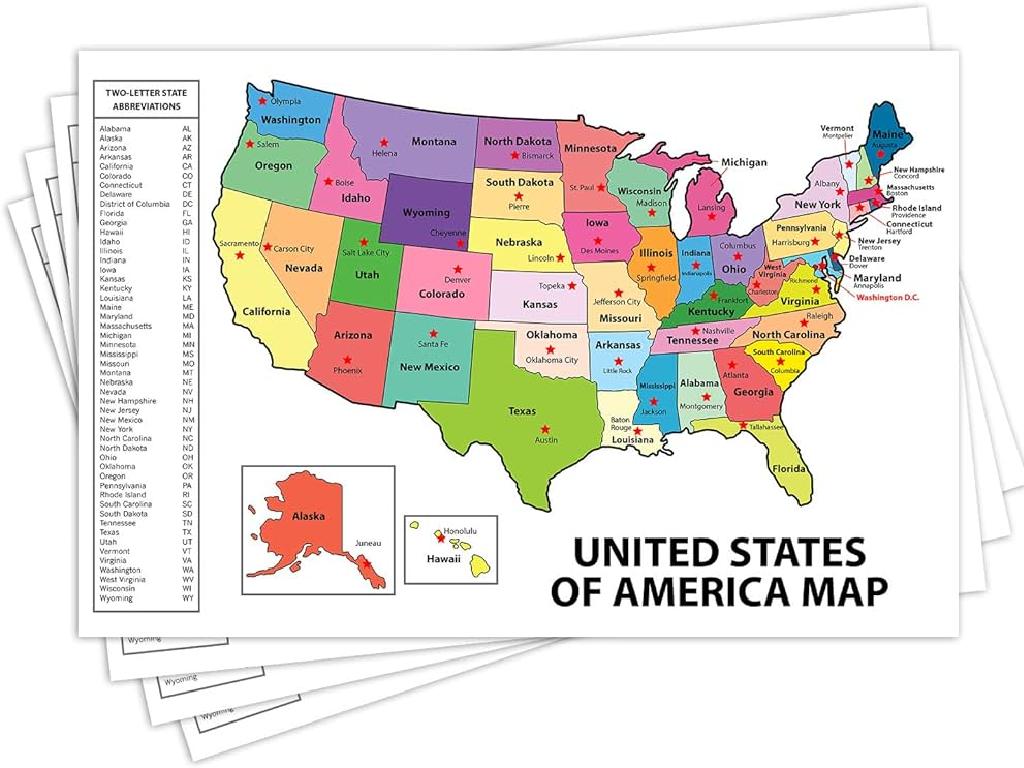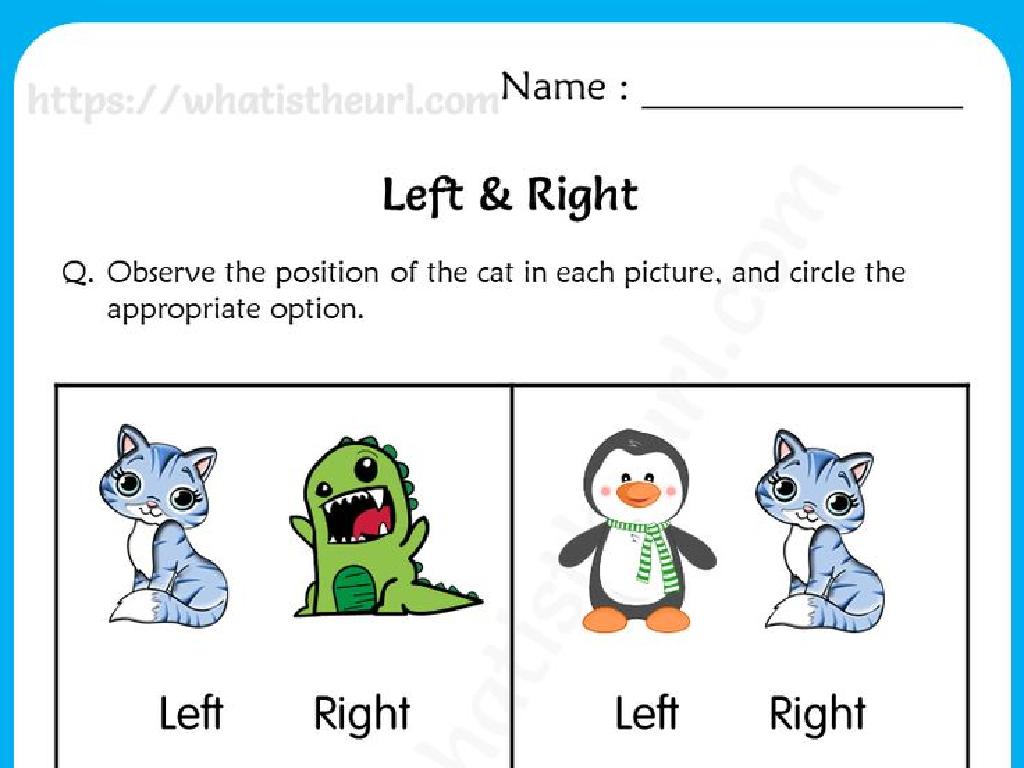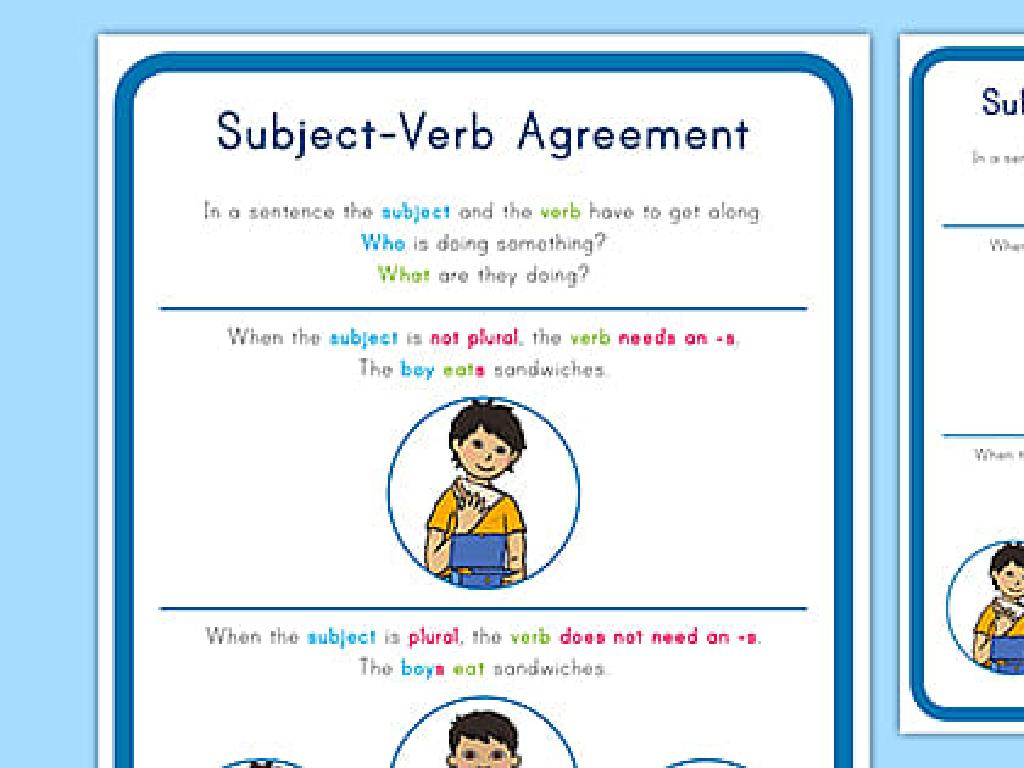Match Causes And Effects In Informational Texts
Subject: Language arts
Grade: Third grade
Topic: Match Causes With Effects
Please LOG IN to download the presentation. Access is available to registered users only.
View More Content
Today’s Adventure: Matching Causes and Effects!
– What are causes and effects?
– A cause is why something happens; an effect is what happens.
– Examples of cause and effect
– ‘It rained, so the ground is wet’ – rain is the cause, wet ground is the effect.
– Become a Cause and Effect Detective
– Use clues in texts to connect events and reasons.
– Practice finding causes and effects
|
This slide introduces the concept of cause and effect, which is crucial for understanding informational texts. Start by explaining that a cause is the reason something happens, and an effect is the result of that cause. Provide clear examples to illustrate the concept, such as natural events or everyday situations. Encourage students to think like detectives, looking for clues in stories or articles that help them match causes with effects. In class, practice this skill with various texts, asking students to identify and match causes and effects. This will help them understand the logical flow of events and improve their comprehension skills.
Understanding Cause and Effect
– What is a ’cause’?
– A ’cause’ is a reason something happens
– What is an ‘effect’?
– An ‘effect’ is the result of a cause
– Action and reaction
– For every action, there is a reaction
– Examples in texts
– Like in a story when a character finds a key (cause) and opens a locked door (effect)
|
This slide introduces the concept of cause and effect, which is a fundamental part of understanding informational texts. A cause is the reason why something happens, and the effect is what happens as a result of the cause. It’s crucial for students to grasp that every action in a story or real life can lead to a reaction or outcome. Use examples from familiar stories or everyday life to illustrate this relationship. For instance, if it rains (cause), the streets get wet (effect). Encourage students to think of their own examples and understand that this concept will help them comprehend the sequence of events in texts they read.
Identifying Causes in Texts
– Look for clue words
– Words like ‘because’, ‘since’, ‘due to’ signal a cause
– Ask: What happened first?
– Example: It rained last night
– ‘It rained last night’ is why the streets are wet (effect)
– Practice finding causes
– Find causes in stories or articles as homework
|
This slide is aimed at teaching students how to identify causes in informational texts. Start by explaining that a cause is why something happens. Introduce clue words that often indicate a cause, such as ‘because’, ‘since’, and ‘due to’. Encourage students to think about the sequence of events and to ask themselves what happened first to determine the cause. Use the example of rain at night leading to wet streets in the morning to illustrate the concept. For homework, assign students to find causes in stories or articles they read, reinforcing the lesson and preparing them for the next class where they will match these causes with their effects.
Identifying Effects in Stories
– Look for result indicator words
– Words like ‘so’, ‘therefore’, ‘as a result’ signal an effect
– Ask: What happened after?
– Example: Flowers growing
– ‘The sun shone brightly, so the flowers grew.’
– Practice finding effects
– Find effects in a story with these clues
|
This slide is aimed at helping third-grade students understand how to identify effects in informational texts. Teach them to look for key words such as ‘so’, ‘therefore’, and ‘as a result’, which often signal that an effect is being described. Encourage them to think about the sequence of events and to ask themselves what happened as a consequence of a particular cause. Use clear and relatable examples, like the growth of flowers due to sunlight, to illustrate the concept. In class, practice this skill by reading passages together and identifying the cause and effect relationships. This will help students to comprehend texts more deeply and improve their critical thinking skills.
Cause and Effect in Stories
– Authors use cause and effect
– It’s like a chain: one thing leads to another in the story!
– Understand character actions
– Why did the character do that? Let’s figure it out!
– Read a story as a class
– Find cause and effect together
– We’ll be detectives in the story, looking for clues!
|
This slide introduces the concept of cause and effect in storytelling, which is a critical component of narrative comprehension. By understanding that authors use cause (a reason something happens) and effect (what happens as a result), students can better grasp the sequence of events and motivations of characters in a story. During the class, read a story aloud and pause to discuss potential causes and effects of actions or events within the text. Encourage students to think about the ‘why’ behind characters’ decisions and the ‘what happened next’ to foster a deeper understanding of the text. This interactive activity will help students recognize patterns and improve their analytical thinking skills.
Cause and Effect Detective Game
– Understand cause & effect cards
– Match cards with correct pairs
– Find the reason something happened and what happened as a result
– Put on your detective hat
– Get ready for a fun challenge
|
This interactive game is designed to help students understand the concept of cause and effect in a fun and engaging way. Each student will receive a set of cards; some cards will have causes and others will have the corresponding effects. The task is to match each cause with its effect. Encourage students to think like detectives, looking for clues in the language to make correct matches. Possible variations of the activity could include working in pairs, timing the game for a competitive edge, or having students create their own cause and effect cards based on a story read in class.
Group Activity: Cause and Effect Chain
– Create a story in groups
– Build a paper chain of events
– Write each cause and effect on a paper strip
– Each link represents a story part
– Link the strips to show the sequence of events
– Present and explain the connections
|
This group activity is designed to help students understand the concept of cause and effect in a fun and interactive way. Divide the class into small groups and provide them with strips of paper. Each group will write a story, and on each strip of paper, they will write down one cause or effect from their story. They will then link the strips together in the correct order to form a chain that represents the sequence of events in their story. Once completed, each group will present their chain to the class, explaining how each link in the chain is connected to the next. This will help students visually see the cause and effect relationship and how events are interconnected. For the teacher: Prepare strips of paper and assist groups as needed. Encourage creativity and ensure each student participates in the storytelling process. Have additional activities ready for fast finishers, such as drawing illustrations for their story or writing additional cause and effect examples.
Cause and Effect Journal Activity
– Think of a personal event
– Journal the cause and effect
– What led to the event? What happened after?
– Share with classmates
– Voluntary sharing helps us learn from each other
– Reflect on the experience
– How did identifying cause and effect help you understand your event better?
|
This class activity is designed to help students apply the concept of cause and effect to their own lives, making the information more relatable and easier to grasp. Students should think of an event, such as a pet learning a new trick or getting a good grade after studying. They will write down what caused the event (studying hard) and the effect (getting a good grade). If they feel comfortable, they can share their stories with the class. This activity not only reinforces the concept of cause and effect but also builds communication skills. For the teacher: Prepare to guide students who may struggle to find an event or to differentiate between cause and effect. Offer prompts or examples to help them get started. Have a list of sharing guidelines to ensure a respectful and supportive environment for those who choose to share.
Detectives of Cause and Effect: Homework Mission
– Celebrating our detective work
– Causes and effects recap
– Causes are why something happens; effects are the results
– Homework: Find cause and effect
– Choose any book and look for a cause and effect example
– Share your findings next class
|
Great job today, class! As we wrap up, remember that causes are the reasons behind why something happens, and effects are the outcomes or results of those causes. For homework, I want each of you to become a detective in your own reading adventure. Find a book you enjoy reading at home and identify one example of a cause and an effect. Write it down and be ready to share with the class in our next session. This will help reinforce your understanding of the relationship between causes and effects in the stories you read. Encourage creativity and praise their efforts in becoming cause and effect detectives!






